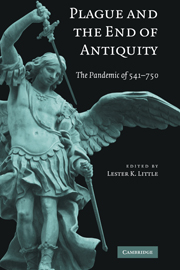5 - Crime and Punishment
The Plague in the Byzantine Empire, 541–749
Published online by Cambridge University Press: 05 June 2012
Summary
The inner structure of the plague's deadly itinerary still escapes us. We can reconstruct the dates of its appearance and disappearance, attempt to trace the mortality it caused, and, in a bold moment, even try to discern its effects on the stricken populations, but all in all, we still can produce only a fragmentary prose about its presence in the Late Antique Mediterranean. Nevertheless, the only way to arrive at a full, all-encompassing picture of this complex phenomenon is to separate fact from interpretation and then assemble these facts to produce a balanced view of the plague, avoiding such extreme positions that either deny the pandemic any importance or make it responsible for every change that followed its course.
We have good reason (and the right) to assume that bubonic plague was the disease that entered the realm of the Byzantine Empire in 541 (and, as such, was within the sphere of interest of Byzantine historians) at Pelusium, a small city on the extreme eastern branch of the Nile's mouth. All of the plague's contemporary authors who produced a description of it, long enough to include a symptomatology, name its most characteristic traits: fever followed by buboes in the groin, axilla, or cervical region.
Pelusium was merely a point of entrance for the disease. Its origin in (Central) Africa is by now well argued for. The same cannot be said for the moment of the pandemic's outbreak.
- Type
- Chapter
- Information
- Plague and the End of AntiquityThe Pandemic of 541–750, pp. 99 - 118Publisher: Cambridge University PressPrint publication year: 2006
- 11
- Cited by

